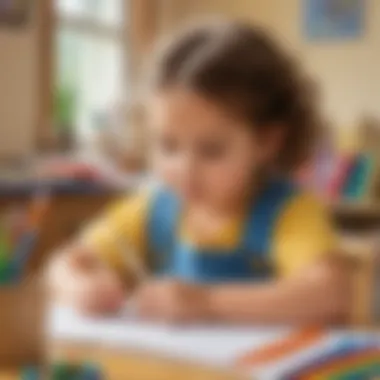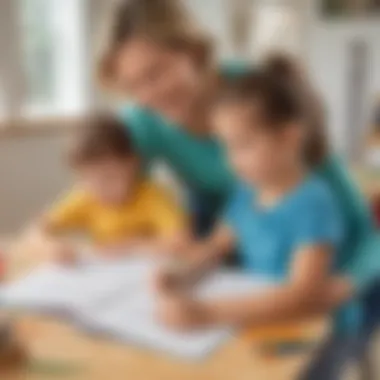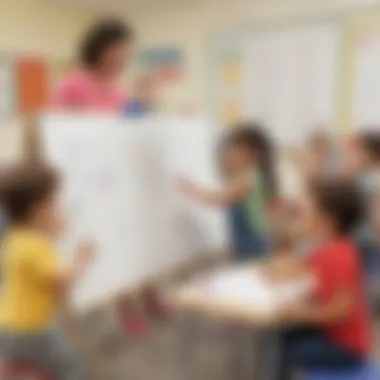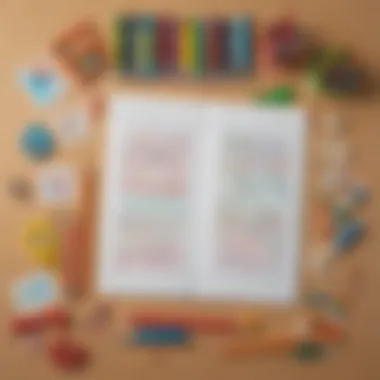Effective Strategies for Enhancing Writing in Pre-K


Intro
When it comes to nurturing the writing skills of preschoolers, numerous strategies can pave the way for success. Early writing practice is not just about putting pencil to paper; it's about igniting a passion for storytelling, boosting fine motor skills, and developing a sense of self-expression. This article provides a roadmap for parents and caregivers to enhance the writing journey of young children. By understanding the specific needs and abilities of preschoolers, you can create an environment ripe for creativity and learning.
Creative Activities
Engagement is the name of the game when dealing with young learners. Creative activities are a splendid way to encourage children to explore writing without the pressure often associated with it. Let’s dive into some ideas that can spark that little writing spark!
Craft Ideas
Crafting can be a wonderful pathway to writing. Here are a few activities that are easily replicable:
- Story Stones: Collect some smooth stones and let kids paint pictures or words on them. Later, they can use the stones to tell their own stories.
- Letter Collage: Provide magazines and allow children to cut out letters or pictures that resonate with them, creating personal collages that can inspire their writing.
- Handmade Notebooks: Teach kids to make simple booklets using folded paper. They can fill these with drawings and words, nurturing a sense of ownership over their writing.
Step-by-Step Guides
To ensure success, clear instructions can make a world of difference. For the Story Stones activity:
- Gather smooth stones and paint.
- Encourage children to choose their favorite characters or themes.
- Once painted, prompt them to make a story using the stones they’ve decorated.
Creating an effective Letter Collage involves:
- Providing age-appropriate scissors and glue.
- Allowing free reign over choosing images and letters.
- Discussing their choices afterwards to inspire further writing.
Educational Value
These activities are not just fun and games; they serve a greater purpose. Crafting enhances fine motor skills, and following steps instills discipline and teaches patience. Such creative hands-on experiences are crucial for pre-writing development. They pave the way for children to connect letters with sounds, ultimately leading to a stronger understanding of language.
Fun Quizzes
Injecting fun into learning is essential. Fun quizzes can help reinforce what children learn while providing a break from traditional writing exercises.
Quiz Topics
The quizzes available on resources like ElemFun cover various topics, including:
- Animals and their habitats
- Shapes and colors
- Numbers and counting
Question Types
These quizzes incorporate a range of question styles:
- Multiple-choice questions help in recognizing correct answers.
- Fill-in-the-blank questions encourage recall of knowledge.
- Picture-based questions can connect visual elements to written words.
Knowledge Reinforcement
Quizzes not only make learning enjoyable but also help solidify the concepts kids learn in a playful manner. Reinforcement through playful quizzes solidifies their understanding and improves retention of information, crucial for later literacy skills.
Fact-Based Articles
Providing well-structured, engaging readings can serve as inspiration for writing.
Topics
The scope is vast with fact-based articles covering:
- Dinosaurs and prehistoric life.
- Space exploration and planets.
- Historical figures tailored for young minds.
Engaging Content
These articles present facts in an engaging format, fostering curiosity. Simple language, colorful images, and interactive elements keep young readers hooked.
Understanding Writing in Early Childhood
Writing is a fundamental aspect of a child’s development that begins as early as preschool. It’s not merely about putting letters on paper; it's the starting point for effective communication and self-expression. Understanding this phase in early childhood education illuminates why nurturing writing skills is crucial for young learners. The ability to write shapes a child's confidence, cognitive abilities, and social interactions.
The Importance of Early Writing Skills
Developing writing skills during the pre-K years serves as a critical building block for later academic success. Essentially, early writing helps children make sense of the world around them. When children scratch out a letter or draw a picture, it’s more than just a fun activity; they are starting to understand that symbols carry meaning. This concept of symbolism is key to literacy.
Moreover, early writers often experience emotional benefits too. They gain a sense of accomplishment when they craft their first letters or words. This boosts their self-esteem and encourages them to take risks in their learning journey. Additionally, writing enhances fine motor skills as children practice grasping and controlling writing tools like crayons, markers, and pencils.


- Benefits of fostering early writing skills include:
- Improved communication abilities
- Enhanced understanding of symbols and sounds
- Development of fine motor skills
- Increased self-confidence
Developmental Readiness for Writing
Understanding when a child is ready to start writing is essential for parents and educators alike. Developmental readiness varies significantly among children, influenced by both age and individual growth patterns. Typically, ages three to five are pivotal; at this stage, many children begin to show an interest in writing. As they approach kindergarten, they may start making letters and approximating words, indicating their readiness.
To determine developmental readiness, observe a child's:
- Interest in Writing: Do they ask to use a pencil? Are they drawing or making marks?
- Fine Motor Skills: Can they hold a crayon or pencil with some control?
- Understanding of Symbols: Do they recognize letters or attempt to write their name?
While it is crucial not to rush a child's writing journey, offering opportunities for exploration can be beneficial. Activities like tracing shapes, using sand or finger paint to make letters, or playing games that involve writing can encourage children to experiment with writing in a low-pressure environment.
Ultimately, respecting each child's unique pace fosters a positive attitude toward writing, laying a strong foundation for their future literacy journey.
Creating a Conducive Environment
When it comes to fostering writing skills in preschoolers, the surroundings they find themselves in play a pivotal role. A conducive environment is more than just a neatly organized space filled with crayons and paper; it’s about creating a space that stimulates creativity and learning. This section will delve into the critical elements that contribute to such environments, touching on physical comfort and emotional robustness—both essential for nurturing young writing talent.
Physical Space for Writing
The physical space designated for writing activities should feel inviting. The furniture needs to be appropriately scaled for small bodies, with tables low enough for kids to comfortably reach. Think about colors too. A bright, well-lit area can make a significant difference, as light influences mood and motivation.
Here are a few elements that can enhance this space:
- Writing Supplies: Stock the area with a variety of writing tools—pencils, colored markers, chalk, and even typewriter or computer options for older preschoolers. Having these items in easy reach prevents interruptions that can break their flow of thought.
- Dedicated Writing Area: Establish a specific corner or nook as the 'writing zone.' This area can have soft seating, clipboards, and large charts that allow children to express their ideas without feeling confined.
- Inspirational Displays: Decorate the walls with visual stimuli; this could be artwork from the children or large printed sentences that encourage them to tell their stories. These can inspire children to engage in writing and stimulate their imaginations.
Emotional Support for Young Learners
Equally important as physical space is the emotional landscape in which children write. Preschoolers are often navigating their developing identities and need emotional support to express themselves freely. Writing can be an intimidating task for little ones, so fostering a warm atmosphere is crucial.
Here are ways to nurture emotional support for young learners:
- Encouragement: Celebrate even the smallest accomplishments. When a child writes their name for the first time or scribbles their first story, respond with genuine enthusiasm. This can bolster their confidence and reinforce the idea that attempts at writing are valued.
- Open Dialogue: Create a rapport where children feel safe to share their thoughts about writing. Ask them open-ended questions about their work to enhance their critical thinking, but do so in a way that feels personal and engaging.
- Model Vulnerability: Share your own writing processes. Kids can learn from seeing you make mistakes or need time to gather your thoughts. This shows them that writing is an ongoing journey, not a destination.
"A writer is someone for whom writing is more difficult than it is for other people." – Thomas Mann
Setting the right emotional tone can make a world of difference in how children approach writing. Recognizing their efforts and providing them with affirmation softens the ground on which their skills will grow.
In sum, crafting a conducive environment for writing in pre-kindergarten settings goes beyond mere physical arrangements. It encompasses a holistic approach that layers emotional security atop well-thought-out spaces. Together, these aspects invite preschoolers to engage in writing, setting the stage for their future literacy journeys.
Techniques to Foster Writing Skills
Writing is a crucial skill that forms the bedrock for children’s academic journey. In preschool, nurturing these skills can open doors for communication and expression. Implementing effective techniques can inspire children to engage with writing, making it an enjoyable process rather than a chore. Developmentally appropriate writing practice not only fosters literacy but also enhances fine motor skills, creativity, and critical thinking. This section elaborates on specific strategies that educators and parents can adopt to make writing both fun and meaningful for preschoolers.
Interactive Writing Activities
Interactive writing is a dynamic approach that allows children to participate in the writing process. This technique revolves around shared writing experiences where children can express their ideas while adults facilitate and guide them. For example, creating a class story can be an enriching experience. The teacher can start with a sentence and invite children to contribute their own ideas, which the teacher writes down. This collaborative effort not only engages children but also shows them the practical use of writing.
Here are some engaging interactive writing activities:
- Big Books: Use oversized books where children can take turns coming up with text or illustrations to add to the story. This tangible method lets them see their contributions come to life on a larger scale.
- Message Boards: Set up a chalkboard or whiteboard for daily communication. Children can draw or write messages to each other or to the teacher, stimulating dialogue through writing.
- Writing Centers: Establish a dedicated area filled with writing tools where they can create short stories, letters, or drawings. Tapping their imagination encourages experimentation with words.
"Writing is a way of talking without being interrupted." – Jules Renard
Incorporating Play into Writing Practice
Integrating play into writing practice is like hitting two birds with one stone. Kids love to play, and when writing becomes part of their play, they may not even notice they're learning. Play allows children to explore and express themselves freely, so why not mesh that with writing?
Here are some practical ideas:
- Role-Playing Games: Set up scenarios where children have to write notes, signs, or menus as part of their role-playing. Playing 'restaurant', for instance, can ignite their desire to write orders or menus.
- Writing as Art: Encourage children to combine drawing and writing. They can tell a story through their drawings and label their pictures with words or phrases, merging artistic expression with literacy.
- Storytelling with Props: Use puppets or animated figures in storytelling sessions. Kids can then write their own storylines based on the characters, prompting a deeper engagement with the narrative.
Using Visual Aids and Manipulatives
Visual aids and manipulatives play an essential role in helping preschoolers grasp writing concepts. These tools can simplify learning and make abstract ideas more concrete. Visuals connect to children’s innate curiosity about the world, aiding them in conceptualizing what they want to express.
Implement these ideas for enhancing writing skills:
- Word Walls: Create a colorful word wall with high-frequency words and pictures. This can serve as a useful reference, making it easier for children to incorporate new vocabulary into their writing.
- Picture Books: Use illustrations from children’s storybooks to inspire their writing. Ask children to describe their favorite scenes or create an alternative ending based on images.
- Manipulative Tools: Use items like letter tiles, stamps, or magnetic letters that children can arrange to form words. These hands-on tools can make the process of word formation engaging and fun.
Incorporating these techniques into writing practice encourages children to view writing as a valuable skill while fostering a love for learning. Whether through interactive activities, playful experiences, or visual supports, there’s an abundance of ways to pull children into the delightful world of writing.


Engaging with Storytelling
Storytelling is like a magic wand in the world of early education. It's more than just telling tales—it's about weaving a tapestry that connects children to words and ideas. When preschoolers engage with storytelling, they open doors to myriad possibilities in writing. This process nurtures their imagination, enhances their communication skills, and lays the groundwork for comprehending narratives and structures in writing.
At this tender age, children are naturally curious and eager to absorb information. Utilizing storytelling not only entertains them but also fosters critical thinking. They learn to ask questions, make predictions, and understand different perspectives. Furthermore, it builds their vocabulary as they encounter new words and phrases. The benefits of storytelling are wide-reaching, impacting children's cognitive, social, and emotional development.
"Storytelling is the capacity to create connections between the self and others through narratives."
Incorporating storytelling into writing practice can be a powerful strategy. It engages preschoolers on levels they naturally understand, paving the way for them to express their thoughts more fluently. Besides that, storytelling offers context for their writing; when they can tell a story, they can better understand how to write one.
The Role of Storytelling in Writing
The role of storytelling in writing for preschoolers cannot be underestimated. When children are exposed to stories, they subconsciously absorb the structure of narratives. They start to grasp concepts like beginnings, middles, and ends. This understanding is crucial as it transforms into a mental blueprint that helps them organize their own thoughts when they eventually put pen to paper.
In many cases, storytelling can also bridge the gap between oral and written language. Children often tell stories aloud before they learn to write them down. This oral practice provides a solid foundation, allowing young learners to experiment with language and develop a sense of narrative flow.
Key Elements of Storytelling in Writing Development:
- Narrative Structure: Understanding the basic framework of stories aids in organizing written work.
- Expression of Ideas: It encourages children to share their thoughts and feelings, paving the way for personal narratives.
- Vocabulary Enrichment: Exposure to different tales introduces diverse vocabulary, which is vital for writing.
Encouraging Children to Create Their Narratives
It's important that caregivers and educators help children not just listen to stories, but also craft their own. Encouraging children to create their narratives boosts their confidence and allows them to express their individuality. A simple prompt can ignite the imagination. For example, asking a child what they would do if they had a pet dragon can lead to delightful stories filled with adventure.
Practical Techniques to Foster Narrative Creation:
- Story Starters: Provide intriguing story beginnings that leave ample room for children to fill in the rest.
- Art Integration: Let children illustrate their narratives. This can solidify their ideas and offers a visual aspect to their stories.
- Collaborative Storytelling: Gather around in a circle and let each child contribute a sentence or two to create a group story. This not only generates a fun narrative but fosters teamwork.
Participating in creating their own narratives doesn't only develop writing skills; it also encourages literacy. Children learn that writing is not just a task but a vehicle for sharing their unique perspectives and experiences. When they feel valued and heard, their motivation to write grows, which can lead to greater literacy development as they progress in their educational journey.
Integrating Technology in Writing Practice
In today’s digital age, technology plays a significant role in how young children learn and engage with the world around them. Integrating technology into writing practice for preschoolers not only captures their attention but also enhances their learning experience. Technology, when used effectively, can support early literacy skills in ways that traditional methods may not be able to achieve. The incorporation of digital tools can motivate young learners, encourage creativity, and facilitate personalized learning experiences. However, it’s crucial to do this thoughtfully, keeping in mind the developmental stages of the children.
Educational Apps for Young Writers
Educational apps are a boon for young writers. They can transform mundane writing tasks into playful, engaging experiences. Here are some notable elements to consider when incorporating these apps:
- Interactivity: Many apps offer interactive features that allow children to drag, drop, and manipulate letters or words. This hands-on approach can make writing feel less daunting.
- Varied Content: Apps like Toontastic and Storybird provide prompts that can inspire children’s imagination, helping them generate ideas for stories.
- Feedback and Assessment: Certain apps like Writing Wizard deliver instant feedback, helping children understand their writing mistakes and learn from them right away.
Though there are countless apps available, it's vital to choose those that align with educational goals. Look for apps designed by educators that focus on skill development rather than just entertainment.
Interactive Online Platforms for Writing
Online platforms bring a communal aspect to writing practice. Children can connect with peers in an engaging environment. This social aspect is crucial, as it provides motivation and allows for collaborative learning. Below are key benefits of using such platforms:
- Community Building: Sites like StoryJumper allow children to share their stories with others. This can foster a sense of belonging and encourage them to write more frequently.
- Diverse Styles and Mediums: Platforms often provide various styles such as comic strips, blogs, or traditional stories. This variety can cater to different interests and help children express themselves creatively.
- Parental Involvement: Many of these platforms include features that allow parents to review their child’s progress, enabling families to engage together in the writing process.
"The integration of technology doesn’t just make writing fun; it lays down the groundwork for 21st-century skills that children will need to thrive in a digital world."
Utilizing educational apps and online platforms can enhance the writing experience for preschoolers significantly. However, it is essential to balance tech use with hands-on, tactile experiences to ensure that children are developing a well-rounded set of skills.
Assessing Writing Progress
Assessing the writing progress of preschoolers is essential for understanding their growth and development in this formative stage. It provides a framework for parents and educators to recognize strengths and identify areas where continued support is needed. By closely observing how children engage with writing activities, we gather vital insights into their literacy skills and natural inclinations toward language. This assessment not only informs instruction but also empowers caregivers in their role.
Effective evaluation strategies allow adults to track progress while ensuring a nurturing environment. This ongoing assessment can cultivate a sense of accomplishment in children as they see growth in their writing abilities. When children understand that their efforts are acknowledged, they often feel more motivated to dive into writing tasks and hone their skills further.
Methods of Evaluation in Pre-K Writing
There are several methods educators and parents can use to assess writing in preschool. These methods ensure that the evaluation is comprehensive, yet simple enough for young learners.
- Observational Assessment: Watching children during writing activities provides direct insights into their process and engagement. This could include noting how they hold a pencil, the types of marks they make, or their interaction with writing materials.
- Writing Portfolios: Collecting samples of a child's writing over time creates a tangible representation of development. A portfolio can include drawings, scribbles, and structured writing, showcasing how their skills evolve.
- Checklists: Simple checklists tailored to various skill areas can help track specific milestones, such as letter formation, spacing, and the use of words. This approach gives a clear picture of where each child stands against developmental benchmarks.
- Peer Review: Encouraging children to share their work with peers fosters a collaborative environment. Feedback from friends can support their revising skills and broaden their confidence.
Utilizing these methods creates a holistic understanding of each child's writing journey. Staying aligned with their emotional readiness is vital, as assessments should feel encouraging, not intimidating.
Celebrating Milestones in Writing Development
Recognizing and celebrating milestones in young children's writing can significantly boost their confidence and enthusiasm. Each small step in their writing journey deserves acknowledgment to reinforce their efforts and achievements. Here are some notable ways to celebrate:
- Display Their Work: Setting up a dedicated space in the classroom or at home where children can showcase their writing can be powerful. This could be a bulletin board or a digital gallery where their progress can be viewed and admired.
- Certificates and Awards: Creating fun certificates for completed writing projects or when they reach specific milestones can motivate young writers. Even simple awards can make a child feel accomplished and valued.
- Share Their Stories: Encourage children to read their stories aloud to their classmates or family members. This not only provides an audience for their writing but also helps them practice verbal storytelling skills.
- Themed Writing Contests: Organizing friendly contests or themes around writing can inspire creativity. Consider seasonal themes where children can express their thoughts, and offer small prizes for participation.


"Every little win matters. Recognizing these small victories can pave the groundwork for a positive self-image in children as writers."
By actively celebrating their accomplishments, caregivers and educators can instill a passion for writing that lasts a lifetime. The focus on progress, both big and small, transforms writing from a chore into a cherished activity, nurturing a lifelong love of language.
The Role of Parents and Caregivers
In the journey of developing writing skills in preschoolers, parents and caregivers stand as the guiding lights. Their involvement not only nurtures a child's love for writing but also shapes their confidence and ability to express themselves. When parents make writing a part of everyday life, children are more likely to view it as an enjoyable activity rather than a chore.
The critical role parents play can be highlighted through various elements such as providing a supportive environment, initiating engaging writing activities, and reinforcing the connection between writing and their child's personal experiences. By creating a culture of literacy at home, parents can ensure that writing becomes deeply embedded in the fabric of their child's learning journey.
"Parents and caregivers are not just supporters; they are the architects of a child's writing journey."
Supporting Homework and Practice at Home
Supporting homework and writing practice at home can be a game-changer for young learners. It's about integrating writing into the daily routine without turning it into a pressure-filled task. Here are a few ideas:
- Set a designated writing time: Making time for writing each day helps establish a habit. Even 10-15 minutes of writing can build significant skills.
- Make it fun: Use colorful pens, unique stationery, or creative prompts. Encourage children to write letters to family members or keep a journal about their day.
- Provide guidance without overstepping: Offer prompts or suggestions when your child feels stuck but allow them the freedom to express their thoughts as they choose.
- Use real-life scenarios: Encourage your child to write grocery lists, thank-you notes, or even short stories about their adventures. This gives writing purpose and relevance.
Being a Role Model for Writing
Children learn immensely by observing adults. When parents and caregivers demonstrate their own writing activities, it can inspire children to view writing as a valuable skill. Here are some approaches parents can take:
- Share your writing: Whether it's jotting down notes or composing a birthday card, let your child see that writing is a part of daily life. Discuss what you’re writing and why it matters.
- Involve them in your projects: When you’re working on a writing task, invite your child to sit with you. Ask for their opinions on what you’re writing, turning it into a collaborative process.
- Talk about the importance of writing: Explain how writing helps people communicate ideas, share stories, and express feelings. This instills an understanding of its value and encourages motivation.
- Encourage reading aloud: Discuss books together, taking time to talk about the author's choices. Engaging children in conversations about writing techniques can spark their interest.
Through these actions, parents and caregivers can actively contribute to their child's writing development. The connection established during these moments proves invaluable, creating a lasting foundation for future literacy skills.
Collaboration Between Educators and Families
The partnership between families and educators plays a vital role in the writing development of young children. When parents, caregivers, and teachers come together, the benefits are multiple. It creates a bridge, ensuring consistency in the messages about the value of writing and establishing a common ground for expectations. This teamwork enriches the learning experience, fortifying a child's confidence in their writing abilities. Together, they can cultivate an environment where writing becomes not just an educational task but an exciting exploration of thoughts and ideas.
Building a Writing Community
Creating a writing community involves fostering connections among families and teachers to share their experiences and resources. This sense of belonging can significantly influence how children perceive writing. When they see their parents engaging in writing-related activities at home, and later hear about those experiences from their teachers, it establishes a clear and supportive narrative around writing. A useful approach in this regard could be hosting family-writing nights, where everyone gathers to write together.
- Benefits of a Writing Community:
- Enhances motivation by exposing children to various writing styles and genres.
- Encourages collaboration between home and school learning processes.
- Provides a support system where families can encourage each other and share challenges and successes.
Such activities not only make writing a communal event but also nurture a love of storytelling and expression early on, igniting the spark of creativity in young minds. When children know that their families and teachers are engaged in the same writing journey, it gives them a reassuring sense of unity.
Sharing Resources and Strategies
Identifying and using shared resources is crucial in making writing a more endemic part of children's daily lives. Families and educators can exchange strategies tailored specifically for pre-K children, with tips that feel manageable and fun.
Here are some effective ways to share resources:
- Newsletters that provide monthly writing prompts or family activity ideas related to writing.
- Social Media Groups for quick tips and sharing successes. Parents might find an interesting approach on Facebook or Reddit where they can discuss and adapt ideas they've discovered.
- Workshops that teach parents fun activities, such as making homemade books or storytelling sessions.
By pooling their resources, families and educators create a rich tapestry of writing experiences. It becomes simpler to maintain a consistent focus on writing as children navigate through learning both at school and home.
Remember, every child is a storyteller, and it's the responsibility of both educators and families to nurture that inherent creativity and curiosity.
Ultimately, effective collaboration lays down a pathway for children to confidently express their thoughts and ideas. It makes writing an exciting venture rather than a daunting task, preparing them for future literacy endeavors.
The Future of Writing in Early Education
The landscape of writing education for young learners is changing, shaped by technological advances and new educational methodologies. This section focuses on the importance of understanding the future of writing in early education. As we explore this evolving landscape, it becomes clear that early writing skills are intertwined with numerous factors, from digital literacy to inclusive practices that cater to diverse learning needs.
Reflecting on the future allows us to equip children with the skills they need to thrive in an increasingly complex world. By fostering early writing development, we not only prepare children for academic success but also encourage critical thinking and self-expression. In this article, we explore noteworthy trends and innovative approaches that herald a new era in early writing education.
"The future belongs to those who believe in the beauty of their dreams." —Eleanor Roosevelt
Trends in Early Writing Education
With the dawn of various trends emerging in early writing education, the focus has shifted from traditional pen-and-paper methods to more diversified approaches. Some key trends include:
- Integration of Technology: The use of tablets and educational apps has revolutionized how children engage with writing. Resources like ABCmouse or WriteReader make practicing writing interactive and fun, encouraging even the most reluctant writers to express themselves.
- Project-Based Learning: This approach encourages kids to work on writing projects that relate to real-world problems or interests. For instance, children might write letters to local leaders about community issues, blending civic engagement with writing practice.
- Inquiry-Based Learning: Encouraging questions and curiosity can inspire young learners to engage with writing more deeply. For instance, taking a nature walk where children write about what they observe not only enhances their descriptive skills but also builds connections to the world around them.
These trends underscore the need for dynamic teaching strategies that cater to the varied interests and skills of young writers.
Preparing Children for Advanced Literacy
As we look forward, one of the paramount considerations is how to effectively prepare children for advanced literacy. This task encompasses more than just the ability to write; it involves nurturing a comprehensive literacy skill set. Some effective strategies include:
- Fostering a Reading Culture: Encouraging children to read diverse genres helps them understand different writing styles and enriches their vocabulary.
- Modeling Thoughtful Writing: Adults should share their writing processes, demonstrating how to craft a story, journal an experience, or jot down ideas. This modeling not only inspires children, but it also shows them that writing is a process that can be refined.
- Providing Constructive Feedback: Constructive and specific feedback helps young writers understand areas for improvement without discouragement. Simple praise, like "I love how you described the tree! It made me see it in my mind!" boosts their confidence while guiding them towards better writing techniques.
Encouraging practices that stimulate both imagination and analysis sets the stage for young learners to transition smoothly into more complex writing tasks in the future.
In summary, embracing the future of writing in early education involves understanding emerging trends and adopting practices that promote comprehensive literacy. By doing so, we ensure that our youngest learners not only succeed in writing but thrive in all facets of communication.







